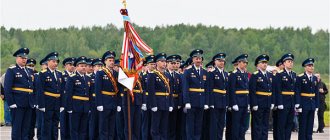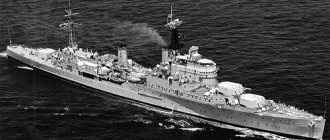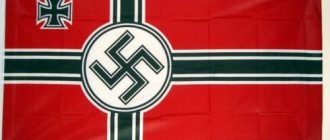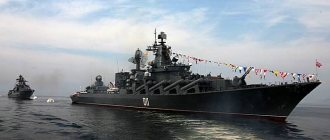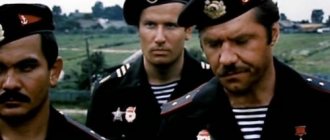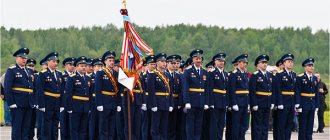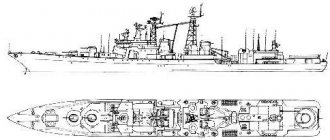Today, the importance of the air force is enormous, and some conflicts in recent decades clearly confirm this.
The Russian Air Force is second only to the American Air Force in the number of aircraft. Russian military aviation has a long and glorious history.
Until 2015, the Russian Air Force was a separate branch of the military, but in August 2015, the Russian Air Force became part of the Aerospace Forces of the Russian Federation.
Story
Officially, the beginning of the existence of the Russian Air Force is considered to be 1904, when the first aerodynamic institute was opened in the city of Kuchino, the head of which was Zhukovsky, one of the creators of aerodynamics in general. Flight schools were opened throughout the country during these years, and already in 1910 the Imperial Air Force was created, which disappeared only after the October Revolution of 1917.
Aviation of the Russian Empire actively defended the country's air borders during the First World War. At the same time, the state’s technology was not at the highest level, and most of the aircraft were created at foreign factories. However, Russia did not lag behind its competitors. For example, by 1915, domestic engineers brought to life the idea of creating a multi-engine bomber, which was named “Ilya Muromets”.
At the time of the First World War, Russian aviation was developing, both the navy and the army had their own aircraft and other aircraft.
Initially, domestic aircraft performed reconnaissance missions, but soon fighters began to be used that took part in air battles. They also began to achieve success in them: the author of the first aerial ram was the pilot Nesterov, who also distinguished himself by performing a loop. After the change of power, great attention was also paid to the development of aviation technology, which ten years later made it possible for the USSR to become a member of the club of the most powerful aviation states on the planet.
Aviation-related educational institutions were opened, talented aircraft designers appeared, and new aircraft models were developed.
Before the Great Patriotic War, USSR aviation rose to a qualitatively new level, new models of military aircraft were produced.
At the same time, at the beginning of the war, the aviation of the Soviet Union suffered defeat after defeat due to the fact that the pilots lacked professionalism, and the German machines were of higher quality. By 1943, the advantage in air battles passed to domestic aviation. German forces began to decline, and Soviet specialists mastered new methods of creating aircraft. The Great Patriotic War claimed the lives of twenty-seven thousand domestic pilots.
During the Cold War, aviation development also received increased attention. In the USSR, new models of military aircraft were developed, such as the Mig-29, Su-27. The situation changed with the collapse of the USSR, when the Air Force, like other military structures, was divided between individual republics.
Officially, the Russian Air Force has existed since 1997. This structure is constantly updated with new transformations, and also takes part in international conflicts.
Attention is paid to pilot training, number of flight hours, professional education and experience of military personnel.
The direct leadership of the air force is exercised by the head of the military space forces of the Russian Federation, Sergei Surovikin.
The Air Force includes not only aviation units, but also other structures: medical, meteorological, logistics and others.
The main commands of the Russian Air Force are located in cities such as Novosibirsk, Khabarovsk, St. Petersburg and Rostov-on-Don.
Main goals
The Air Force (VVS) is a branch of the Russian Aerospace Forces, the most maneuverable and mobile component of the country's army.
The Russian Federation has an Air Force that can be used to resolve any conflicts that pose a threat not only to our state, but also to allied countries. An example is the events in Syria.
The Russian Air Force is called upon to perform the following combat missions:
- Reflecting aggression in the aerospace sphere and protecting state and military authorities, industrial and economic regions, critical infrastructure, and troop groups.
- Defeat objects of military-economic potential, aviation, anti-aircraft, nuclear missile and ship groups of the enemy.
- Transportation by air of military equipment, as well as the drop (landing) of troops and military equipment on enemy territory.
- Support and support of combat operations of the Ground Forces and Navy forces.
- Strategic, operational and tactical intelligence.
REFERENCE. In peacetime, the Air Force is engaged in protecting the borders of the Russian Federation and monitoring the flights of foreign reconnaissance vehicles in the border area.
What does the Russian Air Force consist of and what tasks do they perform?
The main tasks of the Russian Air Force in modern conditions are:
- repelling aggression in the air and protecting the most important objects of the country's economy and infrastructure and groupings of troops (forces) from air strikes;
- defeating enemy targets and troops using both conventional and nuclear weapons;
- navigation support for combat operations of troops (forces) of other types and branches of troops.
Article on the topic
Flying in dreams and in reality. Military pilot about life in the sky and on the ground
According to their purpose, Air Force aviation is divided into:
- distant,
- frontline,
- military transport,
- army
These units may include:
- bomber,
- assault,
- fighter,
- intelligence,
- transport,
- special aviation.
The Air Force is armed with:
- aircraft (Tu-160, Tu-22MZ, Tu-95MS, Su-24, Su-34, MiG-29, MiG-27, MiG-31 of various modifications, Su-25, Su-27, Su-39, MiG- 25R, Su-24MP, A-50, An-12, An-22, An-26, An-124, Il-76, Il-78),
- helicopters (Mi-8, Mi-24, Mi-17, Mi-26, Ka-31, Ka-52, Ka-62),
- anti-aircraft missile systems (S-200, S-300, S-300PM, S-400 Triumph),
- radar stations and complexes (“Protivnik-G”, “Sky-U”, “Gamma-DE”, “Gamma-S1”, “Casta-2”).
Also, fourth-generation aircraft have been replaced by new modifications and modern types of aircraft (helicopters), which have broader combat capabilities and flight performance characteristics. These include various modifications of the MiG-31 long-range supersonic fighter-interceptor, the new-generation An-70 medium-range military transport aircraft, the An-140-100 light military transport aircraft, the modified Mi-8 attack military transport helicopter, multi-purpose medium-range helicopter with gas turbine engines Mi-38, combat helicopters Mi-28 (various modifications) and Ka-52 Alligator.
The strangest and most unusual aircraft in the history of aviation | Photo gallery
The Caspian Sea Monster, also known as the "Caspian Monster", was an experimental ekranoplan developed by the design bureau of Rostislav Alekseev in 1966. © wikipedia.org
VVA-14 (Vertical take-off amphibian, modification: ekranolet 14M1P) is an experimental Soviet aircraft (seaplane, bomber and torpedo bomber) designed by Robert Bartini, a Soviet aircraft designer of Italian origin. Created as a © wikipedia.org
Lockheed XFV "The Salmon", an experimental prototype of an escort fighter with the ability to take off from the tail (1953) © wikipedia.org
De Lackner HZ-1 Aerocycle flying platform designed to carry one soldier (1954). In the center of the platform there was a platform for the pilot, a control panel and several instruments. The pilot could change the speed and direction of movement of the vehicle, see © wikipedia.org
The McDonnell XF-85 "Goblin" is an American jet aircraft designed as an escort fighter that could be based on a heavy bomber. Prototype, not mass produced. The plane was launched from a Boeing EB-29B bomber. In summary © wikipedia.org
The Libellula, a British experimental aircraft with twin wings and two engines, gave pilots excellent visibility when landing on aircraft carriers (1945). © wikipedia.org
The North American F-82 Twin Mustang is an American two-seat long-range fighter. Known as the last piston-powered fighter aircraft of the US Air Force. The XP-82 prototype first flew on July 6, 1945 - too late to take part in World War II © wikipedia.org
Snecma C-450. He made his first free vertical flight on May 6, 1959, but during the transition from vertical to horizontal flight on July 25, the plane crashed; pilot August Morel managed to eject. © wikipedia.org
In the early 30s, engineer Luigi Stipa, who served in the Italian Air Force, proposed an original idea using a tube fuselage to increase the efficiency of the propellers. This concept was called “Ala a turbina”. First flight of the Stipa aircraft, equipped with © wikipedia.org
The Vought XF5U Skimmer was an experimental vertical take-off and landing (VTOL) fighter aircraft that was studied by the US Navy during World War II. By the time the two experimental aircraft were built, the war had already ended and © wikipedia.org
The Caproni Ca.60 Noviplano is an experimental flying boat airliner. The main purpose of the prototype is to test solutions before the construction of a 150-seat trans-Atlantic airliner. The plane had an unusual aerodynamic design: nine wings were arranged © wikipedia.org
Hyper III is a full-size remotely controlled aircraft built at NASA's Flight Research Center in 1969. © wikipedia.org
Blomm+Voss BV 141 is a prototype of a German reconnaissance aircraft. It was distinguished by an asymmetrical airframe structure. The original version of the aircraft with an asymmetrically located cockpit and chopped off horizontal tail, which improved visibility. © wikipedia.org
The B377PG is a NASA super-turbine cargo aircraft that first flew in 1980. © wikipedia.org
VZ-9-AV Avrocar is a vertical take-off and landing aircraft developed by the Canadian company Avro Aircraft Ltd.. Made its first flight on November 12, 1959. In 1961, the project was closed, as officially stated due to the impossibility of the “plate” from © wikipedia.org
. Northrop B-2 Spirit is an American heavy stealth strategic bomber. Designed to break through dense air defenses and deliver conventional or nuclear weapons. © wikipedia.org
The Airbus A300-600ST Super Transporter, also known as the Airbus Beluga, is an Airbus wide-body turbojet cargo aircraft for transporting large cargo. A total of 5 copies of the Airbus A300-600ST were produced, which work practically © wikipedia.org
Structure of the air force of the Russian Air Force
Today, the Russian Air Force is part of the military space forces, the decree on the creation of which was published in August 2022. The leadership of the Russian Aerospace Forces is exercised by the General Staff of the RF Armed Forces, and direct command is exercised by the Main Command of the Aerospace Forces. The commander-in-chief of the Russian military space forces is Colonel General Sergei Surovikin.
The Commander-in-Chief of the Russian Air Force is Lieutenant General Yudin, he holds the position of Deputy Commander-in-Chief of the Russian Aerospace Forces.
In addition to the air force, the Aerospace Forces include space forces, air defense and missile defense units.
The Russian Air Force includes long-range, military transport and army aviation. In addition, the Air Force includes anti-aircraft, missile and radio technical troops. The Russian Air Force also has its own special troops, which perform many important functions: provide reconnaissance and communications, engage in electronic warfare, rescue operations and protection against weapons of mass destruction. The Air Force also includes meteorological and medical services, engineering units, support units and logistics services.
The basis of the structure of the Russian air force are brigades, air bases and commands of the Russian Air Force.
Four commands are located in St. Petersburg, Rostov-on-Don, Khabarovsk and Novosibirsk. In addition, the Russian Air Force includes a separate command that manages long-range and military transport aviation.
As mentioned above, the Russian Air Force is second only to the US Air Force in size. In 2010, the strength of the Russian air force was 148 thousand people, about 3.6 thousand different pieces of aircraft were in operation, and about 1 thousand more were in storage.
After the 2008 reform, air regiments turned into air bases; in 2010, there were 60-70 such bases.
Air Force structure
The Russian Air Force consists of the following branches of troops (forces):
- Aviation, depending on purpose:
- bomber;
- assault;
- fighter;
- air defense;
- intelligence;
- transport;
- special.
- Anti-aircraft missile forces, whose main function is to protect strategic targets, as well as troop groups from air strikes. Anti-aircraft missile systems and systems are used as weapons, which have high firepower and accuracy.
- Radio technical troops performing reconnaissance functions.
- Special troops.
- Units and institutions of the rear.
MiG-29 fighters
Military equipment of Russian aviation
Long-range and strategic aircraft
One of the brightest representatives of long-range aviation is the Tu-160, which bears the affectionate name “White Swan”. This machine was produced during the Soviet Union, develops supersonic speed and has a variable sweep wing. According to the developers, the Tu-160 is capable of overcoming enemy air defenses at ultra-low altitude and delivering a nuclear strike. The Russian Air Force has only 16 such aircraft and the question is: will our industry be able to organize the production of such machines?
The Tupolev Design Bureau's Tu-95 aircraft first took to the air during Stalin's lifetime and has been in service ever since. Four turboprop engines allow long-distance flights along the entire border of our country. It earned the nickname “Bear” because of the bass sound of these engines; it is capable of carrying cruise missiles and nuclear bombs. There are 30 of these machines left in service in the Russian Air Force.
The Tu-22M long-range strategic missile carrier with fuel-efficient engines is capable of supersonic flights and is equipped with a variable-sweep wing; production of these aircraft was launched back in the last century in the 60s. 50 aircraft are in service, a hundred Tu-22M aircraft are mothballed.
Fighter aircraft
The Su-27 front-line fighter was produced in Soviet times and is one of the first fourth-generation aircraft; later modifications of this aircraft numbering about 360 units are in service.
Based on the Su-27, the Su-30 was produced, which has a radio electronic equipment capable of identifying targets on the ground and in the air at a great distance and transmitting target designations to other crews. There are a total of 80 of these aircraft in stock.
An even deeper modernization of the Su-27 was the Su-35 fighter; this aircraft belongs to the 4++ generation, it has high maneuverability and is equipped with the latest electronics.
These aircraft entered combat units in 2014, and the air force operates 48 aircraft.
The fourth generation of Russian aircraft began with the MiG-27; more than two dozen modified models of this aircraft were produced, with a total of 225 combat units in service.
Another fighter-bomber that cannot be ignored is the Su-34, the newest aircraft in service with the Air Force in the amount of 75 units.
Attack aircraft and interceptors
The Su-24 is an exact copy of the F-111 aircraft of the US Air Force, which has not been flying for a long time; its Soviet counterpart is still in service, but by 2020 all aircraft will be decommissioned; currently there are about a hundred similar aircraft in service.
The legendary Su-25 Grach attack aircraft, which has high survivability, was developed so successfully in the 70s that after so many years of operation they are going to modernize it, since they do not yet see a worthy replacement. Today, 200 units of combat-ready vehicles and 100 aircraft are mothballed.
The MiG-31 interceptor develops high speed in a matter of seconds and is designed for a long range. The modernization of this aircraft will be completed by the twentieth year; in total there are 140 such aircraft in units.
The main fleet of transport aircraft are aircraft from the Antonov Design Bureau and several modifications from the Ilyushin Design Bureau. Among them are light transport aircraft An-26 and An-72, medium-duty vehicles An-140 and An-148, and solid heavy-duty aircraft An-22, An-124 and Il-86. About three hundred transport workers carry out tasks for the delivery of cargo and military equipment.
Training aircraft
Designed after the collapse of the Union, the only training aircraft, the Yak-130, went into production and immediately gained a reputation as an excellent training machine with a program for simulating the aircraft for which the future pilot is retrained. In addition, there is a Czech training aircraft L-39 and an aircraft for training transport aviation pilots Tu-134UBL.
Army aviation
This type of aviation is represented mainly by Mil and Kamov helicopters and also by the Kazan Helicopter. After the Ka-50 was discontinued, the Russian army aviation was replenished with a hundred Ka-52s and the same number of Mi-28s. Most of the helicopters in combat units are the proven Mi-8 and Mi-24. There are 570 units of eights in service, and 620 units of Mi-24s.
The reliability of these Soviet machines is beyond doubt.
Unmanned aircraft
The USSR attached little importance to this type of weapon, but technological progress does not stand still and in modern times drones have found worthy use. These aircraft conduct reconnaissance and survey enemy positions, destroy command posts without risking the lives of the people controlling these drones.
The Air Force has several types of UAVs - the Bee-1T and Reis-D, and the outdated Israeli Forpost drone is still in service.
AIR FORCE
MILITARY AIR FORCES (VVS), a branch of the armed forces (AF), designed to repel aggression in the aerospace. sphere and protection from air strikes adm.-political. centers, industrial and economic areas, important objects of the country and groupings of troops (forces), as well as for the destruction of enemy objects and troops using both conventional and nuclear weapons, and to support combat operations of troops (forces) of other types and branches of the Armed Forces.
The world's first four-engine aircraft "Russian Knight" (1913).
The first aircraft for military use. purposes appeared in the beginning. 20th century Military The ministries of France (1909), Russia (1909–11), and other countries began to purchase aircraft and train military personnel. pilots. In 1911, Italy was the first to use aviation for reconnaissance and bombing of enemy troops. In Russia, airplanes were used for the first time in the military. targets during the maneuvers of the St. Petersburg, Warsaw and Kyiv Military District in 1911, where they conducted air. reconnaissance and photographing of the area. He grew up in combat conditions. airplanes were first used in the 1st Balkan War of 1912–1913, in which he grew up. aviation the detachment acted on the side of Bulgaria. By order of the military department dated August 12, 1912, all issues of the organization and development of the military. Russian aviation were transferred to Gl. management of the General Staff, in which an Aeronautical Unit was created for this purpose (the date August 12, by Decree of the President of the Russian Federation, was established as Russian Air Force Day). To the beginning During the 1st World War, Russia had St. 200 military aircraft, Germany - St. 230, France – approx. 160, Austria-Hungary – St. 60, UK – St. 50, USA and Italy - 30 each. Military. airplanes could reach speeds of up to 120 km/h, reached a height of 4 thousand m and used hl. arr. for air control reconnaissance and artillery fire correction. In 1914, Russia adopted the world's first 4-engine bomber, the Ilya Muromets, which could carry up to 400 kg of bombs, and by March 1915 a squadron of 10 such aircraft was formed. The use of reconnaissance aircraft and bombers during the war gave impetus to the intensive development of means of combating them - anti-aircraft artillery and fighter aircraft, and air defense troops and fighter aircraft emerged. During the years of World War I, the total number of aircraft of the warring countries increased tenfold. Types of aviation were distinguished: reconnaissance, fighter, bomber. Quantitative and qualitative development of aviation. technology increased the role of aviation in combat, operations and war in general. The struggle for air supremacy began to acquire great importance. After World War I, the growth of air forces continued in all countries. The air was especially rapidly increased. power in the 1930s in the context of the outbreak of an arms race, preparations for a new war.
Sov. The Air Force was created together with the Red Army. On Dec. 1917 as part of the People's Commissariat for Military Affairs. All-Russian Affairs was established. Air Management Board Republic Navy. The transition to the construction of a regular air force began in 1918; on May 24, Ch. Directorate of the Workers' and Peasants' Red Military Air Force. Fleet, and in September - the Field Directorate of Aviation and Aeronautics of the active army. By Nov. 1918 as part of the Sov. The Air Force was 38, and by Dec. 1920 – 83 air squadrons (including 18 naval squadrons). On the Civil Fronts. During the war of 1917–22, up to 350 Sovs operated simultaneously. airplanes. In the post-war years, simultaneously with the quantitative and qualitative growth of the Air Force, its organization improved. structure. Red Military-Air. The fleet in 1924 was transformed into the Red Army Air Force, which in 1932 received independent status. branches of the military and consisted of military aviation (as part of combined arms corps), army (as part of combined arms armies) and front-line (VVS VO). In May 1932 they became independent. branch of the Air Defense Forces, and in 1933 - heavy bomber aircraft as a means of the High Command. In 1938 owls. Naval aviation was withdrawn from the Air Force and became one of the branches of the fleet. In 1936–38, operational aircraft were created as part of the Air Force. associations - three special-purpose armies of mixed composition, designed to solve independent problems. operational and strategic. missions in the theater of operations, but in 1940 they were disbanded and long-range bomber aircraft were created on their basis. bodies of homogeneous composition. In 1937–38, air defense corps were formed for the air defense of Moscow, Leningrad and Baku, an air defense division for Kyiv, and air defense brigades for other large cities. In the 1930s A powerful aviation force was built in the country. industry In 1940–41, serial production of new fighters Yak-1, MiG-3, LaGG-3, Pe-2 bombers and Il-2 attack aircraft was mastered. Only for 1940 and the 1st half. 1941 St. was released. 12 thousand combat aircraft. However, to rearm the Sov. Air Force for new types of aircraft before the start of Vel. Otech. the war failed. 76-mm, 85-mm and 37-mm semi-automatic anti-aircraft guns entered service with units of the Air Defense Forces. guns, searchlight stations, barrage balloons, RUS-1, RUS-2 radars and other equipment. But in general, the combat readiness of the Red Army Air Force did not meet the requirements of that period. 25.2.1941 The Central Committee of the All-Union Communist Party of Bolsheviks and the Council of People's Commissars of the USSR adopted a resolution “On the reorganization of the aviation forces of the Red Army.” Started Vel. Otech. The war did not allow the completion of the planned activities, but the foundation was laid, which made it possible to recreate the Air Force after the heavy defeats of the initial period of the war.
Multipurpose aircraft Su-2 (1940, USSR).
By the beginning of World War 2, Germany had approx. 4.1 thousand, Italy - St. 2.8 thousand, Japan - approx. 3.8 thousand, UK - approx. 3.9 thousand, France - St. 3.3 thousand, USA - approx. 1.6 thousand combat aircraft. Aviation units were created as part of the air forces of a number of countries. associations capable of solving operational and strategic issues. tasks. In Germany, such associations were 5 air. fleets, each of which included 800–1200 various aircraft. branches of aviation and was intended to perform combat missions in cooperation with an army group and independently. Over the years Vel. Otech. owl wars The Air Force was radically reorganized. By decision of the Headquarters of the Supreme High Command (SHC) on June 29, 1941, the post of Air Force Commander was established - deputy. People's Commissar of Defense, Military was created. Air Force Council. Measures have been taken to accelerate the commissioning of aircraft. factories, the construction of which began before the war. In a short time it was possible to significantly increase the power of the owls. Air Force. The Air Force began to receive new fighters Yak-7b, Yak-9, Yak-3, La-5, La-7, two-seat attack aircraft Il-2, and since the summer of 1944 - Il-10, front-line bombers Tu-2, long-range bombers Il-4 and Pe-8, Li-2 transport and landing aircraft (licensed version of Douglas DC-3); guns, bombs, radio and radar. stations, air navigation equipment and other equipment and weapons. During the war years, serial production of 25 new types of aircraft was established (including modernization); total aviation industry released St. 125.6 thousand aircraft, including combat and military transport aircraft - 119.3 thousand. Allied supplies amounted to approx. 20 thousand aircraft. It means they happened. changes in the structure of the Air Force. During 1942, all combat aviation was withdrawn from combined arms armies and corps, and the air forces of all fronts were converted into air forces. army, which made it possible to massively use aviation in Ch. directions of troop action and centrally manage it. In March 1942, long-range bomber aviation was reorganized into long-range aviation and subordinated to the Supreme Command Headquarters, and in December. 1944 The 18th air force was created on its basis. army. Significant structural changes took place in the Air Defense Forces. On Nov. 1941 The air defense forces of the country were separated into independent units. type of aircraft. In Jan. In 1942, as part of the Air Defense Forces of the country, air defense aviation was formed as a branch of the military, to which 40 fighter aircraft were transferred from the Air Force. regiments
During the war years, the principles, forms and methods of using the Air Force were improved. Departments were formed. aviation Reserve Corps of the Supreme High Command, which ensured the rapid concentration of large aviation forces in the main area. directions of action of ground forces. The most important form of use of the air force was air. operations for the purpose of defeating (weakening) aviation. groups, destruction of operational reserves and disruption of their transportation, destruction of important military-industrial enemy centers. The combat actions of Air Force formations in combined arms operations acquired new content. By mid-summer 1943, Owls. The Air Force has firmly conquered the strategic air supremacy. Over the years Vel. Otech. they made wars St. 3.1 million combat sorties and inflicted great damage on the enemy in manpower and military equipment. Of the 77 thousand aircraft lost by the enemy to the Soviet-German. front, owls 57 thousand were destroyed by aviation, of which 44 thousand were destroyed by air. battles and 13 thousand at airfields. Anti-aircraft artillery of the Air Defense Forces destroyed St. 7 thousand enemy aircraft. Total combat losses of the Sovs. aviation during the war years on the ground and in the air amounted to approx. 45.6 thousand aircraft. For the courage and courage shown by St. 200 thousand aviators were awarded orders and medals, 2420 were awarded the title of Hero of the Soviet Union. Union, 65 pilots were awarded this title twice and 2 pilots three times. 897 air formations and units were awarded Orders of the USSR, 708 received honorary titles and 228 were awarded the title of Guards.
Strategic bomber "Mirage" IV (1959, France).
Russian strategic missile carrier Tu-95MS (1988, USSR).
In 1946, the position of Commander-in-Chief of the Air Force was introduced - deputy. Minister of Armament Forces (then Deputy Minister of Defense) of the USSR. The Air Force headquarters was transformed into Chief. Air Force headquarters. The Air Force as a branch of aviation included long-range (1946), military transport (1955), and fighter-bomber (1957, instead of attack). In con. 1950s As a branch of air defense troops, anti-aircraft missile forces are formed. During the post-war period, air defense troops passed through several. stages of reorganization. Sov. The Air Force switched from piston aircraft to jet aircraft, and various helicopters were created. destination, helicopter units were formed. The use of turboprop and turbojet engines made it possible not only to increase the speed (up to 3500 km/h) and altitude (over 20 km), but also to significantly increase the flight range (over 10 thousand km) and the carrying capacity of aircraft. To ensure reliable aircraft navigation, accurate bombing and shooting, aircraft are equipped with electronic equipment, and airfields are equipped with more modern equipment. radio engineering aircraft landing systems. In the 1960s The Air Force is receiving new weapons - aircraft. art. weapons with a large supply of ammunition and grenades, guided and unguided missiles, bombs and missiles with nuclear charges; organization is being improved. structure of parts, connections and associations. The fighting in Afghanistan in 1979–89 required the revival of attack aircraft at a new qualitative level. One of the components of strategic nuclear forces became long-range aviation, the basis of which was missile carriers of large payload and range. Front-line aviation received supersonic all-weather bombers, fighter-bombers, attack aircraft, fighters, reconnaissance, transport and special aircraft. aircraft. Military transport aviation received modern equipment. heavy cargo aircraft. Long-range and military transport aviation have become a means of the High Command.
Leading Western Air Forces states (USA, UK, France, Germany) in the post-war period were also equipped with jet aircraft. equipment, missiles and bombs, etc. classes and purposes, which were actively used during local wars. In the construction of the air force of most Western countries. states paid special attention to the development of tactical tactics. aviation as the main means of delivery operational-tactical. nuclear weapons and troop support. The basis of the tactical aircraft fleet. aviation consisted of fighters F-15, F-16, F-111, F-117, A-6, A-10 (USA), Tornado, Jaguar, Harrier, Lightning (UK), Mirage V, Mirage 2000, Mirage F.1C (France). Strategic aviation was equipped with strategic jets. bombers B-1B, B-2A, B-52N (USA), Vulcan, Victor (Great Britain), Mirage (France), etc.
The Russian Air Force was created in 1998 on the basis of the unification of the Air Force and the Air Defense Forces of the country in accordance with the Decree of the President of the Russian Federation of July 16, 1997, which provided for the concentration of control of all troops and forces conducting combat operations in the air and from the air under a single command. In 2003, army aviation was transferred to the Air Force from the Ground Forces. The Russian Air Force includes: aviation, anti-aircraft missile forces and radio engineering. troops that are branches of the Air Force, as well as special forces. troops (intelligence; communications; radio technical support and automated control systems; electronic warfare; engineering; radiation, chemical and biological protection; search and rescue; meteorological; technical support) and logistics. Depending on the purpose and subordination, Air Force aviation is divided into long-range, front-line (operational-tactical), army and military transport; Based on the tasks to be solved and the nature of the actions, it is divided by type of aviation into bomber, attack, fighter, reconnaissance, transport and special. Organizationally, the Russian Air Force includes: Special Command. assignments (the main link of the country's aerospace defense); air army of the Supreme High Command strategic. appointments; air Army of the Supreme High Command of Military Transport Aviation; air force and air defense armies; air armies; military educational institutions, research and testing institutions, formations and units center. subordination, centers for combat training and retraining of flight personnel.
Russian front-line bomber Su-24 (1977, USSR).
In service with aircraft. Long-range aviation regiments consist of strategic. missile carriers-bombers Tu-160, strategic. Tu-95MS missile carriers, Tu-22M3 long-range missile carrier-bombers and Il-78T tanker aircraft. Strategic missile carriers are armed with high-precision aircraft. strategic air-to-surface cruise missiles in nuclear and conventional equipment (Tu-160 also with aircraft bombs), long-range missile carrier-bombers - aircraft. bombs and air-to-surface guided missiles cf. ranges in nuclear and conventional equipment. The range of the Tu-95MS and Tu-160 with a full combat load and without refueling in flight is up to 5.5 thousand km, the Tu-22M3 is up to 2.1 thousand km. Aviation Front-line aviation regiments are armed with: Su-24M front-line bombers with a range of up to 630 km and max. combat load 8 tons; Su-25 attack aircraft with a range of up to 470 km and max. combat load 4 tons; fighters MiG-31, Su-27 and MiG-29 various. modifications with a range from 400 km to 1500 km and max. combat load from 3 to 7 tons; operational-tactical reconnaissance aircraft Su-24MR and MiG-25RB; transport helicopters Mi-8 decomp. modifications. Aviation Army aviation regiments are armed with Mi-24 combat (attack) helicopters. modifications (which are planned to be replaced by K-50, K-52 and Mi-28 helicopters), Mi-8MT transport and combat helicopters, Mi-26 heavy airborne transport helicopters, VR-3D (Reis-D) unmanned reconnaissance aircraft . In service with aircraft. Military transport aviation regiments consist of military transport aircraft: strategic (long-range heavy) An-124 and An-22, operational-strategic (heavy) Il-76 various. modifications, auxiliary (light) An-26.
Anti-aircraft missile units of the Russian Air Force are armed with long-range air defense systems (up to 400 km) S-400 etc. range (up to 150 km) S-300 (PS, PMU), capable of hitting aircraft (helicopters), cruise missiles and operational-tactical warheads. ballistic missiles on the final section of the flight path at altitudes from 10 m to 185 km. Guaranteed probability of destruction with one air launch. targets 0.8 or more, aeroballistic. goals 0.6–0.7.
Radio engineering Russian Air Force troops are represented by radio engineering. brigades and regiments armed with various radars. radio wave ranges. Air detection range and aeroballistic. targets depends on the altitude of their flight and is at altitude. up to 100 m – 40–50 km, 500 m – 80–90 km, 1 km – up to 360 km. The visibility zone of over-the-horizon radars is from 900 to 2800 km.
Air Forces of most Western countries. states organizationally include aviation. commands uniting formations and tactical units. fighters, attack aircraft, reconnaissance and military transport aircraft and helicopters, and the US, British and French Air Forces - strategic formations. aviation and ballistic rockets. The air forces of a number of states include air defense formations and units, and in the United States - forces and means of warning about a nuclear missile strike and space control. space. The USA has aircraft. command in various zones of the globe (in the Pacific region, in Europe, on the Alaska Peninsula, in Central and South America). The US Air Force in Europe forms the basis of the combat power of the joint NATO Air Force, which is armed with aircraft. parts - modern supersonic aircraft equipped with high-precision guided bombs and missiles capable of carrying nuclear warheads.
Prospects for the Russian Air Force
Work is currently underway on the creation of several aircraft, some of them are in the final stages.
The main new product, which should soon enter service with the Russian Air Force and significantly strengthen it, is the Russian T-50 fifth-generation front-line aviation complex (PAK FA). The aircraft has already been shown to the general public several times, and prototypes are currently being tested. Information appeared in the media about problems with the T-50 engine, but there was no official confirmation of this. The first T-50 aircraft should enter service in 2021.
Among the promising projects, it is also worth noting the Il-214 and Il-112 transport aircraft, which should replace the outdated Anas, as well as the new MiG-35 fighter, they plan to begin delivering it to the troops this year.
In the near future, new machines are planned to be supplied to the troops and helicopter manufacturers: the Mi-38 and Ka-60 are undergoing the final stages of testing.
Work has begun on the creation of a new Russian “strategist” (PAK-DA), but it is likely that we will see it only after 2021.
Russian Air Force symbols
As for the symbols of the air force, the department's chevron has a shield shape. Certain objects are depicted on a blue background, depending on which department the individual employee belongs to. The Obtex sewing production is engaged in professional embroidery of chevrons; if you wish, you can order Russian Air Force chevrons for the required number of people on the official website of our production.
In addition, the Russian Air Force has a special distinctive sign. This is a red star, which is framed by red and white lines. The same symbols, albeit slightly larger, have been used by the USSR Air Force since 1943. The Belarusian Air Force has a similar sign.
The flag of the Russian Air Force depicts half-wings of aircraft crossing each other, flanked by bird wings. This is all against a background of blue and yellow stripes, interspersed.
Modern Air Force uniform
The uniform for military personnel of the Air Force is created, first of all, for convenience in everyday wear and differs depending on the status of the employee and his gender.
There are several options for uniforms:
- Uniform for privates and cadets, the summer version of which consists of a blue suit, white T-shirt, black boots and a field cap.
- The winter version consists of a camouflage suit, a T-shirt and cap of the same color, a muffler and a khaki coat, black boots and gloves.
- Two options for everyday uniforms have been developed for officers:
- Summer, consisting of blue trousers and a jacket, a blue shirt and a black tie with a gold tack. The headdress is a blue or khaki cap. Black boots are provided for the feet.
- Winter uniform, which is similar to the summer one and is complemented by a gray or blue coat with a gray earflap hat and black gloves.
- The uniform of senior officers is similar, the difference is that it is complemented by a detachable gray astrakhan collar and a gray hat.
- The uniform for female military personnel also has two options:
- Summer, consisting of a blue or khaki skirt and jacket and a similar blouse, as well as a black tie with a gold tack. The headgear is a blue or protective cap. Black or flesh-colored shoes and boots are acceptable as footwear.
- Winter, complemented by a blue or khaki muffler, as well as a blue or gray coat. Headdress – gray astrakhan beret.
REFERENCE. A dress uniform has also been developed for Air Force personnel, which has some differences from everyday
Military uniform of the Russian Air Force
Interesting facts about the Russian Air Force
The commander of the Russian Air Force since 2015 is Lieutenant General Andrei Yudin.
According to the Russian Ministry of Defense, over the current decade the number of flight hours of the department's pilots has increased. Every year this figure increases by several percent.
This department is now in service with a huge number of aircraft, including Su-27, Su-30, Su-35 fighters, supersonic bombers Tu-160, Su-24.
The Air Force of the Russian Federation carries out a lot of important strategic tasks every day: they monitor the inviolability of the air and space borders of the state, take part in international conflicts, one of the parties to which is the Russian Federation, and also participate in various kinds of parades of military equipment, in particular on the Day Victory.
The department's forces are constantly being modernized and undergoing changes. The government and the Ministry of Defense are carrying out reforms and measures aimed at improving the functioning of the structure (for example, the 2008 reform). Aviation equipment is replenished with the latest combat units, which are immediately tested and put into use.

